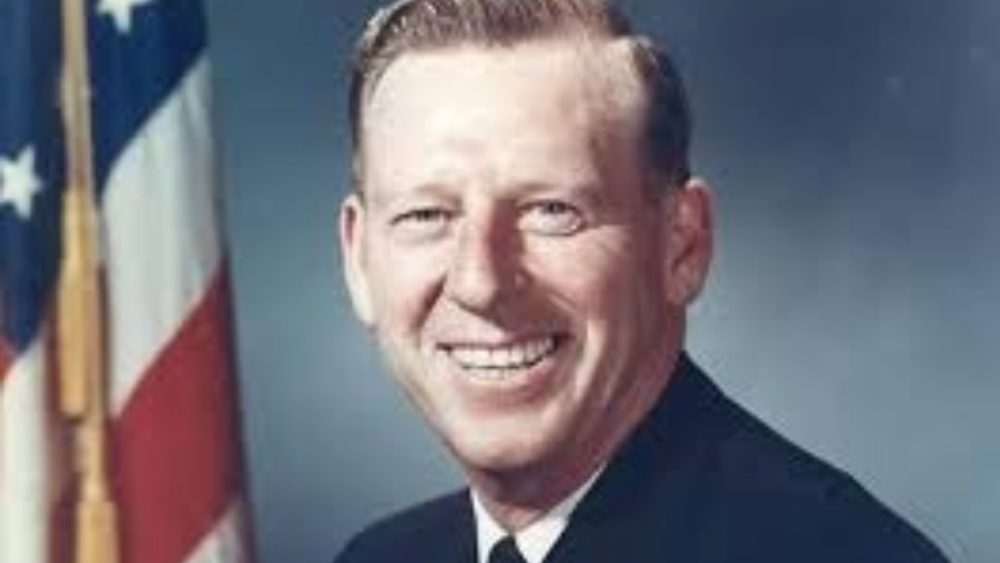On the U.S. Navy’s birthday, we celebrate its adaptability. The service innovates constantly. Daring individuals push its limits. They drive technology and doctrine forward.
Rear Admiral Eugene Bennett “Lucky” Fluckey stands out. A submariner, he was fearless and inventive. Fluckey’s dedication to his crew was profound. His leadership made the USS Barb famous. It became the most celebrated fighting vessel of World War II.
Fluckey’s career shows true audacity. It demonstrates modern leadership. His victories came from meticulous planning. Fluckey’s commitment to his crew was unwavering. His story shows how ingenuity and daring create power. He forged decisive power beneath the waves
The Makings of a Submarine Pioneer
“Lucky” Fluckey was born in Washington, D.C., in 1913, but his roots were forged in self-reliance and challenge. He was an Eagle Scout at a time when that designation required serious outdoor grit and leadership. That innate curiosity and drive allowed him to graduate high school early and enter the U.S. Naval Academy at the age of seventeen, graduating in 1935
Fluckey started on surface ships and destroyers. But the submarine service drew him in. Its technical challenges appealed to his mind. He joined in 1938. Submarines were then changing from coastal curiosities to real stealth weapons. Fluckey saw a field ready for innovation. He realized that quick thinking and engineering skills were critical. These skills, honed by his academic studies and experience, could impact global conflict.
The pre-war period was essential. The submarine community valued ingenuity and technical mastery. Undersea operations were isolated. A commander needed to solve complex problems alone. This demanding environment built Fluckey’s rigorous foundation. It led to his wartime success.
Commanding the USS Barb: A Tactical Laboratory
By 1944, the Pacific War had settled into a brutal, grinding phase where the stakes were existential. Fluckey took command of the USS Barb and immediately began transforming her into an unconventional weapon. His initial focus was on the most precious commodity in the submarine force: the crew. He trained his sailors to view every patrol not as a rote exercise, but as a problem in creative tactics, encouraging them to find new ways to locate, evade, and strike the enemy.
This culture of ingenuity led to one of the most audacious technological modifications of the war: Fluckey and his team fitted the Barb with deck-mounted rocket launchers. It was a move virtually unheard of for an American submarine. The strategic purpose was to allow Barb to bombard Japanese shore installations after expending its torpedoes, extending the boat’s utility far beyond conventional anti-shipping missions. This innovation was a clear signal to the Japanese—and to the rest of the U.S. Navy—that Fluckey was not content with fighting the last war; he was determined to invent the next one.
The Barb quickly became the scourge of the Pacific, amassing an astonishing record of sinkings. Fluckey’s daring was always predicated on meticulous training and calculated risk, ensuring that the crew was ready for any scenario.
The Medal of Honor Patrol: Daring in Namkwan Harbor
Fluckey’s Medal of Honor patrol in early 1945 perfectly encapsulated his calculated audacity. The mission required the Barb to penetrate Namkwan Harbor on the coast of China, a critical Japanese logistics hub. The harbor was supposedly impenetrable—protected by minefields, patrol boats, and anti-submarine nets, with water so shallow that it was considered impossible for a fleet submarine to operate effectively.
In the dark of night, Fluckey threaded the Barb through the mined shallows. It was a nerve-wracking gamble that relied on the crew’s expertise in navigation and the boat’s engineering integrity. Once inside, they unleashed a precise salvo of torpedoes, sinking a huge Japanese ammunition ship and damaging several escorts. The resulting explosions crippled the Japanese supply chain in the region.
The escape was as dramatic as the attack. Fluckey piloted the Barb out through enemy nets and minefields at high speed. The risk was enormous, but the victory justified the peril, showcasing a blend of minute planning and combat daring. This feat proved that under the right leadership, the American submarine force could reach the enemy’s most protected sanctuaries.
The Impossible Raid: A Ground Attack on Japan
If the harbor attack was daring, the Barb‘s final, most improbable exploit was truly revolutionary: a shore raid on the Japanese home islands.
In an act that defies the conventional definition of submarine warfare, Fluckey selected a small landing party, insisting on unmarried volunteers (and uniquely, favoring men with scouting backgrounds who were used to operating autonomously). This team of only eight men went ashore and planted explosives beneath a coastal railway near the town of Karafuto.
The resulting detonation destroyed a 16-car train without a single casualty to the raiding party.
This small, perfect mission holds a massive historical footnote: it was the only U.S. ground action on Japan’s home soil during the war. It was the ultimate expression of Fluckey’s belief that no tactic was too unconventional if it could hasten victory and spare Allied lives. He saw the vulnerability and seized it, demonstrating that a submarine could serve not only as a strike platform, but also as a stealthy insertion and extraction vessel for special operations.
The “Lucky” Fluckey Formula: Safety Through Audacity
The incredible string of aggressive actions and high-risk maneuvers under Fluckey’s command is often overshadowed by one remarkable fact: despite dozens of combat encounters and daring actions, the USS Barb never lost a man in combat.
Fluckey himself attributed this to relentless drills and meticulous planning. For him, risk was not reckless; it had to be calculated. His command style was built on an empowering belief in his crew’s ingenuity. If a machinist’s mate had an idea to improve a pump, or a radar operator suggested a better pattern for evading depth charges, Fluckey listened. This democratic approach to problem-solving ensured that every sailor felt responsible for the Barb‘s success, creating a unified and technically superb fighting unit.
This focus on the sailor earned him the respect of his men and the highest honors, including the
Medal of Honor and four Navy Crosses—one of the highest totals for any submariner. Yet, he wore them lightly, once stating that his true reward was seeing his crew come home alive and victorious
Enduring Legacy of the Submarine Force
Fluckey’s service to the Navy extended well beyond V-J Day. He continued to guide the service, using his wartime experience to influence submarine development and strategic thinking. His principles of stealth, surprise, and decisive action remain the cornerstone of U.S. submarine doctrine, guiding the Navy as it faces modern challenges like cyber warfare and undersea deterrence.
Today, the Navy’s newest submarines carry weapons and sensors far beyond anything imagined in 1945, yet the spirit of the Barb endures. The unofficial motto of the submarine force,
“Run silent, run deep,” echoes the principles Fluckey lived by on every patrol. He transformed a steel tube into a precision instrument of strategy, proving that daring can be disciplined, and setting a standard of moral courage and ingenuity that continues to define the service.
When we mark the Navy’s birthday, we salute not only the founding fathers but also the visionaries like Eugene B. “Lucky” Fluckey, whose leadership and creativity ensured the Navy remained the world’s most potent force beneath the waves.










